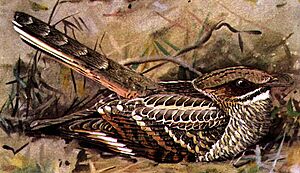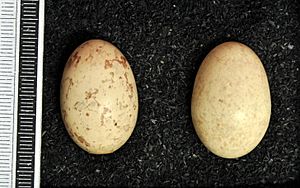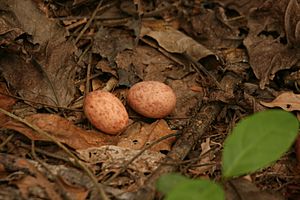Pauraque facts for kids
Quick facts for kids Pauraque |
|
|---|---|
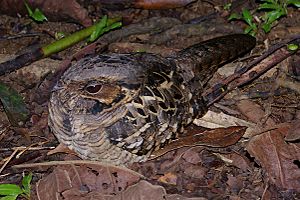 |
|
| Common pauraque | |
| Conservation status | |
| Scientific classification | |
| Genus: |
Nyctidromus
|
| Species: |
albicollis
|
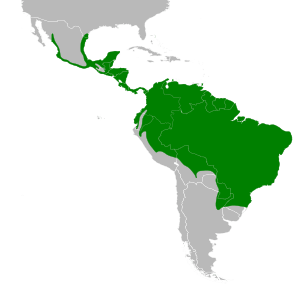 |
|
The pauraque (Nyctidromus albicollis) is a type of nightjar bird. It is also known as the common pauraque to tell it apart from other similar species. This bird is one of two in the Nyctidromus group.
Pauraques live in warm, wet areas of the New World. This includes subtropical and tropical regions. Most pauraques stay in the same place all year. Only those living farthest north might move for winter.
Contents
About the Pauraque
The pauraque is a medium-sized nightjar. It is about 8.7 to 11 inches (22 to 28 cm) long. These birds can have two main color patterns. Their feathers might be grayish-brown or reddish-brown.
They have a long tail and wide, rounded wings. You can spot a buff-colored ring around their eyes. They also have a stripe on their face that stands out against their reddish cheeks.
Male and Female Pauraques
Adult male pauraques have a white band near their wing tips. Their outer tail feathers are mostly white. Female pauraques have a narrower wing band. The white on their outer tail feathers is also less noticeable.
There are seven different types, or subspecies, of the pauraque. They vary a bit in size and how gray their feathers are.
Pauraque Sounds
The male pauraque's song can change a lot. It often includes a whistle that sounds like "weeeow wheeooo" or "who-r-you." They also make soft "puk puk" sounds. During courtship, the male might flutter around the female. He makes a "whip" sound as he flies. The female's call is a quick series of "whip" sounds.
Where Pauraques Live and How They Live
Common pauraques breed from southern Texas down to the lower Paraná River area. Most groups of these birds live in the same place all year. However, pauraques that breed in the U.S. might spend winter in eastern Mexico.
In the southern parts of their home range, one subspecies, N. a. derbyanus, lives. It can be found from central and southern Brazil into parts of Bolivia. It also lives through Paraguay into Argentina and Uruguay. Even the birds farthest south do not seem to migrate. But in these areas, the species is only found in certain spots. For example, it is not known to breed in Entre Ríos Province in Argentina. It is also rare in Rio Grande do Sul, Brazil. Not much is known about its presence in Uruguay. However, a good number of them live along the Yaguarón River.
Pauraque Habitat
Pauraques live in open woodland and grassland areas. They can also be found in scrubland and farm fields. This bird has long legs for a nightjar. Its lower legs are bare. It spends more time on the ground than most of its relatives.
If disturbed, it might run away instead of flying. They often rest on roads and paths. Pauraques generally prefer mixed habitats. They like places with thick plants to hide in during the day. This could be a forest. At night, they prefer open areas to hunt. This might even include rivers or wetlands.
Night Life and Food
The pauraque is a nocturnal bird, meaning it is active at night. Like other nightjars, it starts flying at dusk. It eats insects that it catches in the air. It usually hunts by flying out from a low perch. It also looks for food over open ground.
Reproduction and Eggs
Pauraques do not build a nest. They lay their two long, oval-shaped pinkish eggs right on the bare ground. Sometimes they lay them on a bed of fallen leaves. Occasionally, only one egg is laid.
Conservation Status
The pauraque is not considered globally threatened. The IUCN lists it as a Species of Least Concern. This means it is not in danger of disappearing.
This bird can adapt well to changes humans make to their habitat. It has even benefited from some deforestation. When trees are cut down, it creates areas with low, new growth. These areas allow the birds to hunt more easily. However, they will leave places that are heavily built up or completely cleared. Also, they are very vulnerable to being hunted by feral dogs and cats. They disappear from areas where these animals are common.
See also
 In Spanish: Chotacabras pauraque para niños
In Spanish: Chotacabras pauraque para niños



